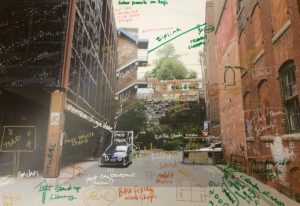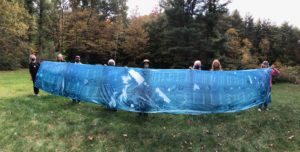Ask The River
Ask The River
Brattleboro, Vermont, is situated on the scenic Connecticut River, but that might be easy for residents and visitors to overlook. The buildings of town’s quaint main street are situated with their backs to the river, which for most of the town’s history was an economic engine rather than an amenity. Three local artists are leading…
Location
Brattleboro, Vermont
Partners
Downtown Brattleboro Alliance, Local artists Andrea Wasserman, Elizabeth Billings and Evie Lovett
Public Funding Includes
National Endowment for the Arts: Our Town
Vermont Arts Council: Animating Infrastructure
State of Vermont: AARP grant program in partnership with Vermont Department of Housing and Community Development, Vermont Department of Health and Community Workshop
Brattleboro, Vermont, is situated on the scenic Connecticut River, but that might be easy for residents and visitors to overlook. The buildings of town’s quaint main street are situated with their backs to the river, which for most of the town’s history was an economic engine rather than an amenity. Three local artists are leading the way to reconnect the town to its public spaces and its river.

Photos courtesy of Ask The River
The Town of Brattleboro secured a 2012 National Endowment for the Arts Our Town grant to support cultural asset mapping and public art. Artists Andrea Wasserman, Elizabeth Billings and Evie Lovett worked together to devise five interrelated works of public art designed to activate conversations and awareness about the relationship between the town and river. One piece was an installation that would animate an alley in the center of town next to a public parking garage at the Brattleboro Transportation Center. Local residents perceived the alley and parking garage as dark, uninviting and even unsafe, but they needed to traverse the area on almost a daily basis in order to access the transportation center. Wasserman, Billings and Lovett pitched an idea to the town leaders that would enliven the alley and spark a connection with the river a few blocks away.

Photos courtesy of Ask The River
The three artists designed and installed a kinetic sculpture made of thousands of discs on the side of the parking garage. The discs move and flash in the wind and sunlight, mimicking the movement of water in the river. The installation also included a video showing footage of the river overlaid with silhouettes of town residents, projected on the blank alley wall opposite the parking garage.
The installations debuted in 2016 and the kinetic sculpture was so successful that the artists and the Downtown Brattleboro Alliance began thinking about how to build on it and make it a permanent feature. In 2019, the Downtown Brattleboro Alliance won an Animating Infrastructure grant from the Vermont Arts Council to support the design of a permanent public art piece. The three artists devised Ask the River. This communitywide process would involve a permanent kinetic sculpture, public performances and participatory art making using cyanotype, a sunlight-sensitive coating on silk fabric with blue tones reminiscent of water. They launched their activities with an exhibit at the Brattleboro Museum and Art Center.
The three artists led the way throughout the process, including fundraising from private foundations and a neighborhood based crowdfunding platform to support the work. Wasserman, Billings and Lovett had worked together, and separately, to make commissioned public art for years. But raising money to support their vision was a new experience. Wasserman explained, “Along the way, we started to think of ourselves as the client and decided what we could do in the community [as opposed to] having a public art project and not necessarily being the boss of it,” which can be the more typical frame for artists. “It’s been an interesting road because we are all quite uncomfortable asking for money,” said Lovett. “We never had to think about the money before,” echoed Billings, but she continued, “It’s also tremendously empowering and a bit scary. To believe in something and ask for it and receive it is amazing.”
The artists formed new partnerships as part of their fundraising and planning process, with entities such as foundations, local businesses and community nonprofits. This required them to expand the scope of the projects, as the partners’ goals and interests helped drive the outcomes of the work. “If you’re asking for funding, ask for advice,” Wasserman counseled; potential partners might have both to offer. “Over the course of a year and a half of doing this, we have received an education,” Billings noted. “Applying for grants with different requirements makes you think of things in different ways.” Lovett explained that the artists ended up engrossed in topics that were new to them: “We’ve incorporated community art making, activation of space, considerations of how to make bathrooms accessible and an elevator available, and lighting.” These new experiences helped the three artists enrich the work they did in the community.
One grant was a collaboration of key stakeholders. The artists, community members, and town and state groups all met at an AARP Placemaking Project event and then worked together on a project. Representatives from Downtown Business Alliance, the Town of Brattleboro, local businesses located in the alley, and the Brattleboro Area Prevention Coalition secured funding from AARP Vermont to create Alley Lane, a pop-up gathering place in the alley during a community art walk.

Photos courtesy of Ask The River
Ask The River has made impacts on the community as well as on the artists themselves. “Because we have such ownership [of the Ask The River project], we now have relationships that we feel are going to be drivers on what we do next,” Wasserman said, noting that they are now working with a community group that helps unsheltered people. “When you get into that merry-go-round of funding and responsibility, it’s rewarding and beautiful, but it’s more than just getting money and being free to make something,” she continued. “We’re not only trying to make art, but contributing back to the community. I would like to see ourselves as players in the community versus just art makers.”
Downtown Brattleboro Alliance Executive Director Stephanie Bonin agrees that artists are important players in the community. “I think [art] is an afterthought in so many projects. When you have artists at the table in whatever you’re creating, your outcome is going to look very different than if you didn’t have artists at the table. A lot of times, people find a solution and then plug artists into it later. The answer is to have all the right people at the table from the beginning.”

